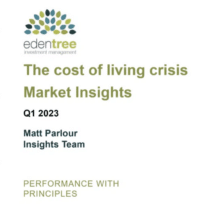Susannah Streeter, senior investment and markets analyst, Hargreaves Lansdown compares the first warning signs of the Financial Crisis and today’s economic uncertainty and market volatility.
‘The first drops of rain hinting that a financial storm could be on the way fell when on 9 August 2007 the French bank BNP Paribas froze three of its US funds, citing problems in the US subprime mortgage markets. Those cooling splashes heralded a deluge of destruction which ripped through financial markets.
Trillions of dollars of loans made to borrowers with poor credit scores had been sliced up, repackaged and sold on financial markets with a woeful lack of oversight and when the housing bubble burst, it rocked the financial institutions which had bought into the derivatives dream. There were other doom-laden dates to come in the thunder and lightning which followed as banks stopped lending to each other, but 9 August marked the first seizing up of the system. The funds were suspended and investors were prevented from drawing out their cash, after BNP Paribas judged it had become impossible to value the assets, with a highly questionable quality mark attached by ratings agencies.
The financial crisis exposed major vulnerabilities not only within banks, which had become household names, but also revealed big flaws in the economic health of Eurozone member states in the years that followed. Bail outs came thick and fast, with investors losing confidence in banks and then countries’ ability to service their huge debts.
Parallels with now
On the face of it, there are parallels to be drawn with today, given the volatility wracking equities, movements in the bond markets signifying potential recessions and red-hot property prices showing signs of cooling. There are fresh worries that the Eurozone could be facing a severe crisis, this time prompted by an energy shock.
The good news is that UK banks are considered to be sufficiently capitalised and strong enough to deal with the risks of a sharper deterioration in economic outlook. In its most recent report into risks to financial stability, the Bank of England says although the outlook for the UK and globally has worsened, UK banks have capacity to support lending to households and businesses. Rules to ensure UK banks’ retail and investment arms are ring fenced came into force in 2019, aimed at preventing contagion in case risk-taking prompted fresh global economic shocks.
Consumers might be coping with the biggest hikes in prices in four decades right now but compared to the months before the 2008 financial crisis hit, the Bank of England believes households aren’t as likely to dig themselves deeper into more debt. The Bank expects businesses on the whole to struggle on. It’ll be more challenging for smaller firms to repay borrowing and the expectation is that some businesses will fail, but overall, it’s going to take a much larger shock to see a domino collapse of companies unable to pay their debts.
The not-so-good news is that central banks have fewer tools at their disposal to deal with today’s looming economic storm. Back in August 2007, interest rates in the UK were at 5.75% compared to 1.25% today, which provided the Bank of England with plenty of room for manoeuvre. In the years that followed, the rate dropped rapidly to stimulate demand in the economy and a mass bond buying programme was launched to reduce borrowing costs. Today those levers can’t be used as they are creaking under the strain of being pulled to get us through the pandemic. With interest rates lowered to ultra-low levels, the era of cheap money has helped fuel the fires of inflation which central banks are now desperate to put out. So, instead of heading into a downturn, with the expectation there will be another lifeline thrown to pull the economy out of a crisis, the aids currently deployed are being withdrawn rapidly.
The governor of the Bank of England, Andrew Bailey, has stressed the over-riding importance of bringing down inflation to the 2% target, saying there will be no ifs and no buts put in the way. It’s far from a comfortable place to be, but an economy losing steam is considered to be the price to pay to stop an inflationary spiral in its tracks. The extra difficulty facing policymakers is that much of the inflation is imported and driven by external shocks rather than by domestic forces, which will make it much harder to push down the spiral of prices.
Housing bubble
With rates expected to keep marching upwards, the risk of a housing market bubble rapidly deflating are also rising. The ring-fencing rules designed to make banks more robust have been blamed for fuelling the rise in prices. The criticism is that the new regime trapped a big cushion of a money within the UK banking fence and the extra liquidity washing around helped fuel the era of very cheap mortgage deals. However, a Treasury report earlier this year cited ultra-low rates brought in by the Bank of England and pandemic support for the housing market as the bigger drivers of the intense mortgage competition in recent years.
There is some concern about the number of UK mortgage holders who are reliant on short-term mortgage deals in comparison with other countries. Homeowners on ultra-cheap, two-year rates are likely to find that their financial resilience will fall as they face the shock of higher monthly payments. In the United States and in many parts of Europe, longer term mortgages have become much more the norm, insulating more households from the short-term shock of steep rate rises. Longer term rates are becoming more popular in the UK, which could help mitigate risk to the market overall.
There are other clear and present dangers on the horizon. Emerging markets are highly sensitive to surges in commodity prices, fresh Covid waves are a continued risk and China’s fragile property market is still seen as a potential threat to stability. Although right now the UK financial system looks ready to keep calm, carry on and cope with the ongoing turbulence, another bolt from the blue still risks shattering confidence and resilience.
The Bank of England is uneasy at the expectation that the buck will always stop at Threadneedle Street and that as an institution it will always be able to step in and try and save the day. It’s also highly concerned that the way commodity markets operate risk amplifying supply crises. Going forward, it’s likely to require more market participants and not just the big banks to make sure they have built up enough buffers to adequately insure against severe but conceivable shocks.
Economic uncertainty and market volatility can be unnerving for investors, but tough times have been shown not to last forever, and markets eventually recover. With inflation appearing to run rampant and a recession looming there are clearly tougher times ahead for consumers and companies but it’s important for investors to think about their long-term strategy and stay resilient when markets are jittery. We don’t know exactly what is round the corner but keeping calm and carrying on, instead of impulsively selling, might benefit you in the long run when prices eventually recover.


































